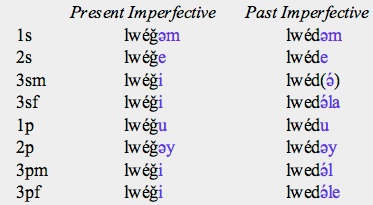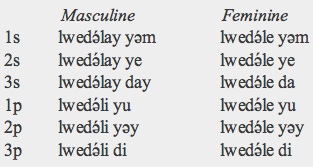An insatiable appetite for ancient and modern tongues


Classification. Indo-European, Indo-Iranian, Iranian, Southeastern Iranian.
Overview. Pashto is the national language of Afghanistan and the tongue of the Pashtuns, the tribes that founded the Afghan state in 1747. They live on both sides of the border between Pakistan and Afghanistan which was drawn in 1893 cutting Pashtun territory in two. Pashto is the second most widely spoken Iranian language after Persian. Located in an area subject to many invasions and transcultural currents, Pashto has been affected in its sounds, syntax and lexicon by neighboring Indo-Aryan languages. It also has been influenced by Persian and Tajik (a form of Persian).
Distribution. It is spoken mainly in southern Afghanistan and western Pakistan. In Afghanistan it is found south of the Hindu Kush mountain chain (with some pockets in the north). In Pakistan, in Khyber Pakhtunkhwa (formerly North-West Frontier Province) and Baluchistan as well as in the city of Karachi located in the southeast of the country (Sindh Province).
Speakers. It is difficult to estimate accurately the number of Pashto speakers, because of disagreement about the percentage of Pakistanis who speak the language (between 10 to 20 % of the population). In Afghanistan it is spoken by 40-60 % of the population. The total number in all countries is between 33 and 50 million of which 20 to 35 million in Pakistan, 13 to 18 million in Afghanistan, 125,000 in the United Arab Emirates, and 120,000 in Iran.
Status. Pashto is one of the two official languages of Afghanistan (the other is Afghan Persian or Dari). In Pakistan it is recognized as a regional language.
Varieties. The main criteria to distinguish Pashto dialects is phonological. Western and Eastern dialects differ in the pronunciation of the retroflex fricatives; Waziri is remarkable for the particular pronunciation of certain vowels; Wanetsi is an archaic form spoken in Baluchistan (Pakistan).
Oldest Documents. The first written records are, probably, from the 13th century. There are disputed claims that a recently discovered manuscript includes poetry from the 8th century.
Phonology
Vowels. Pashto has 7 simple vowels and 7 diphthongs:
a) Monophthongs

b) Diphthongs: ay, a:y, aw, a:w, əy, uy, oy.
Consonants (29). In contrast to other Iranian languages, Pashto has several retroflex consonants due to the probable influence of Indo-Aryan languages. Another distinctive feature of Pashto phonology is the frequent presence of consonant clusters at the beginning of a word.

The following phonemes occur only in the 'elegant pronunciation' of Arabic and Persian loanwords: [f] (fricative labial), [q] (uvular stop), [ʔ] (glottal stop).
Script and Orthography. Pashto uses the Perso-Arabic alphabet with the addition of some letters to represent peculiar Pashto sounds. In the first column the Pashto alphabet is shown, in the second its transliteration into the Latin alphabet, and in the third one the equivalents in the International Phonetic Alphabet.


Morphology
-
Nominal. Nouns, adjectives and pronouns are inflected for gender, number and case.
-
-
•gender: masculine, feminine. Nouns ending in consonant, -ay or -u are usually masculine. Nouns ending in -a, -əy, or -o are usually feminine. Nouns ending in other vowels may be either gender.
-
•number: singular, plural. There is a great variety of plural markers, many animate masculine nouns make their plurals with -ān while inanimate masculine ones use -un.
-
•case: direct, oblique, vocative. There are just two cases, direct and oblique, though in the singular there is also a vocative. The oblique case is governed by adpositions (prepositions and postpositions). Besides suffixes, they are marked also by alterations of stem vowels and stress.

-
There are two types of case marking: in most masculine nouns the singular direct and oblique cases are the same; in most feminine nouns the oblique singular is identical to the direct plural. However, some masculine and feminine nouns display the opposite pattern. All oblique plurals end in -o. The declension of masculine šāgərd (‘student’), and feminine xədza (‘woman’) is shown above.
-
•articles: there are no articles. A demonstrative or the word yaw ‘one’ may be used instead.
-
•pronouns: personal, demonstrative, interrogative, indefinite.

-
Personal pronouns may be independent or clitics used as subject or object as well as in possessive constructions.
-
There are no specific 3rd person pronouns, they are provided by the proximate demonstrative.
-
The oblique pronouns preceded by j or s function as possessive pronouns.

-
-
Demonstrative pronouns distinguish three degrees: proximate, intermediate and remote (shown in the table to the right).
-
The proximate demonstrative pronouns serve also as third person pronouns.
-
The interrogative pronouns are ‘who’ (direct cok, oblique ča, possessive da čā), and ‘what’ (direct and oblique cə).
-
The place of a relative pronoun is taken by the conjunctive particle če (‘that’).
-
Verbal. There are two stems, present and past, based on which present and past tenses are formed with the addition of personal endings in simple tenses or by a combination with an auxiliary verb in periphrastic tenses. Verbs are inflected for number, person and gender.
-
•person and number: 1s, 2s, 3sm, 3sf; 1p, 2p, 3pm, 3pf. In the present there is a common form for the 3rd person, irrespective of number. However, in the past tense gender and number are distinguished in the third person.
-
•aspect: perfective, imperfective. The aspectual distinction between perfective and imperfective pervades the entire verbal system.
-
•tense: present (imperfective and perfective), past (imperfective and perfective), future (imperfective and perfective), present perfect, past perfect, future perfect, conditional, perfect conditional, potential present, potential past.
-
To indicate tense there are two different stems, present and past. From the present stem two presents (imperfective and perfective) and two imperatives (imperfective and perfective) are formed. From the past stem two pasts (imperfective and perfective) are formed. Besides these simple tenses, there are periphrastic ones, including the whole perfect system, the potential (which expresses capacity), and the passive.

-
The imperfective present and imperfective past are formed with the present and past stems + personal endings. In the present, there is only one form for the 3rd singular and the 3rd plural; in the past, gender is distinguished in both cases. For example, the conjugation of lwedə́l (‘to fall’) is:
-
Personal endings for the first and second persons are common to both tenses.
-
We show below the 3rd person singular conjugation of lwedə́l in different tenses and moods:
-
a) Simple conjugations. Perfective stems are formed by adding the prefix wə- to the imperfective stem.
-
Present. The imperfective present parallels the English simple present or present continuous. The perfective present functions mainly as a subjunctive; it expresses admonition or doubt in independent clauses, and potential action in dependent clauses.
-
‣ Imperfective: lwéǧi (falls, is falling).
-
‣ Perfective: wə́lweǧi (if it falls).
-
Past
-
‣ Imperfective: lwedə́ (was falling).
-
‣ Perfective: wə́lwed (fell).
-
The addition of the particle ba gives a customary sense:
-
‣ Customary Imperfective: lwedə́ ba (used to fall).
-
‣ Customary (repetitive) Perfective: wə́balwed (used to fall repeatedly).
-
Future. It is formed with the addition of the particle ba to the present:
-
‣ Imperfective: lwéǧi ba (will be falling).
-
‣ Perfective: wə́balweǧi (will fall).
-
Imperative. The imperative has distinctive personal endings: singular a, plural -əy which are added to the present stem. There is a negative imperative marked by the prohibitive particle mə.
-
‣ Imperfective: lwéǧa (keep on falling).
-
‣ Perfective: wə́lweǧa (fall).
-
Conditional: it has three forms which express present or future conditions. -āy is used for all persons.
-
1) lwedā́y (if it were falling).
-
2) wə́lwedāy (if it were to fall).
-
3) lwedā́y ba (then it would fall). It expresses possible consequences.
-
b) Periphrastic conjugations: include the perfect system, the potential and the passive. They are formed by combining the past participle with a conjugated auxiliary verb.

-
For example, the present perfect (‘has fallen’) is formed with the present imperfective of the auxiliary ‘be’ (which is irregular) + past participle (shown in the table).
-
The future perfect, lwedə́lay ba wi (‘if it will have fallen’), is similar to the present perfect but accompanied by the future marker ba. In the 3rd person singular and plural the special form wi of the verb 'to be' is used.
-
The past perfect, lwedə́lay wə (‘had fallen’), is formed with the past participle + the past tense of 'to be'.
-
Conditional perfect I: lwedə́lay wāy (‘if it had fallen’).
-
Conditional perfect II: lwedə́lay ba wā́y (‘then it would have fallen’).
-
Forms expressing the potential mood, combine simple conditional forms and the auxiliary verb šwəl:
-
Potential present: (wə́)lwedā́y ši. Potential past: (wə́)lwedā́y šu.
-
•voice: active, passive. The periphrastic forms tend to have a passive sense as they use a (passive) past participle. However, a true passive voice only occurs when the agent is unknown or not expressed. It is formed by the infinitive combined with the auxiliary verb kedəl/šwəl ('become'). A full passive, with the agent expressed by a prepositional phrase is rare.
-
•derivation: the number of simple verbs is not great, but many more verbs can be formed by compounding. Compounds often resort to the verb kawl ('to make'). For example, 'to play' may be expressed as lobe kawl (‘game-make’).
-
•non-finite forms: infinitive, past participle. The infinitive is derived from the past stem by adding -əl = lwédəl. The past participle is formed with the past stem plus the suffix -ay: lwedə́lay = fallen.
Syntax
Word order is a quite rigid Subject-Object-Verb:
-
sar̂áy x̌ə́ja wíni
-
man woman sees
-
The man sees the woman.
All modifiers precede the head of a noun phrase. Adjectives must agree with the head-noun in gender, number and case and are placed directly before the noun. If the modifier is another noun or pronoun implying a genitive relation it is preceded by a preposition and takes the oblique case:
-
də hághə sar̂i lās
-
PREP OBL OBL NOM
-
of that man hand
-
The hand of that man.
-
də māzigar zyerr lmar
-
PREP OBL NOM NOM
-
of afternoon yellow sun
-
The yellow sun of the afternoon.
Postpositions appear at the end of the entire phrase, but a preposition must be placed immediately before the head and its attributes.
Pashto has ‘split ergativity’ which is determined by transitivity and tense. In intransitive verbs the subject is in the direct case and the verb agrees with it. Transitive verbs derived from the present stem behave in the same way. But in those derived from the past stem the subject adopts the oblique case and the object the direct case; moreover the verb agrees with the object (and not with the subject).
Lexicon
The oldest loanwords are from Greek, introduced in Afghanistan in the 3rd century BCE with the invasion of Alexander and the subsequent foundation of the Greco-Bactrian kingdom. With the arrival of Islam many Arabic and Persian words were adopted. The neighboring Indo-Aryan languages have made also their contribution to Pashto vocabulary.
Basic Vocabulary
one: yaw
two: dwa
three: dre
four: tsalor
five: pindzə
six: špaẓ
seven: uwə
eight: atə
nine: nəh
ten: las
hundred: səl
father: plār
mother: mor
brother: wror
sister: xor
son: zuy
daughter: lur
head: sar
eye: čašm, stərga
foot: pā
heart: zr̂ə
tongue: ẓéba
Key Literary Works (forthcoming).
-
© 2013 Alejandro Gutman and Beatriz Avanzati
Further Reading
-
-'Pashto'. D. N. MacKenzie. In The World's Major Languages, 460-475. B. Comrie (ed). Routledge (2009).
-
-'Pashto'. B. Robson & H. Tegey. In The Iranian Languages, 721-772. G. Windfuhr (ed). Routledge (2009).
-
-A Grammar of Pashto. H. Penzl. American Council of Learned Societies (1955).
Pashto

Address comments and questions to: gutman37@yahoo.com
MAIN LANGUAGE FAMILIES
LANGUAGE AREAS
Languages of Ethiopia & Eritrea
LANGUAGES by COUNTRY
LANGUAGE MAPS
-
• America
-
• Asia
-
Countries & Regions
-
-
Families
-
• Europe
-
• Oceania